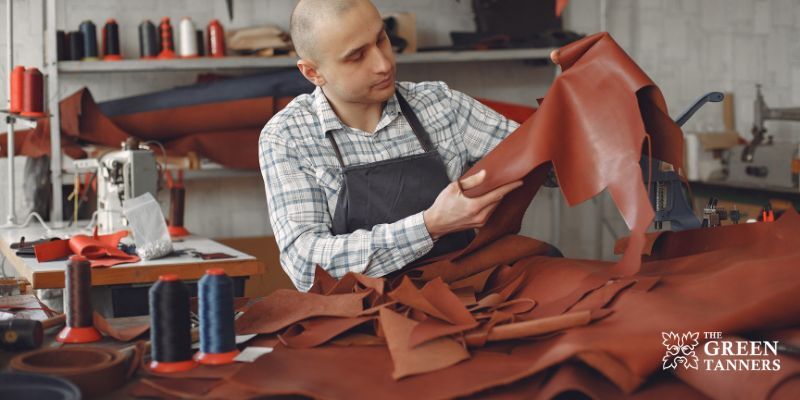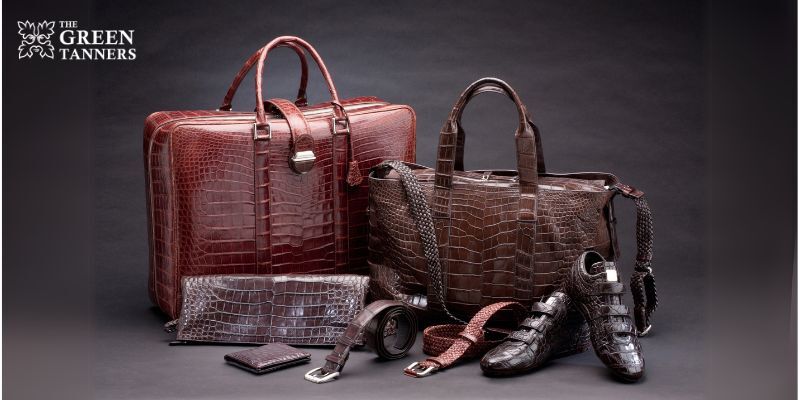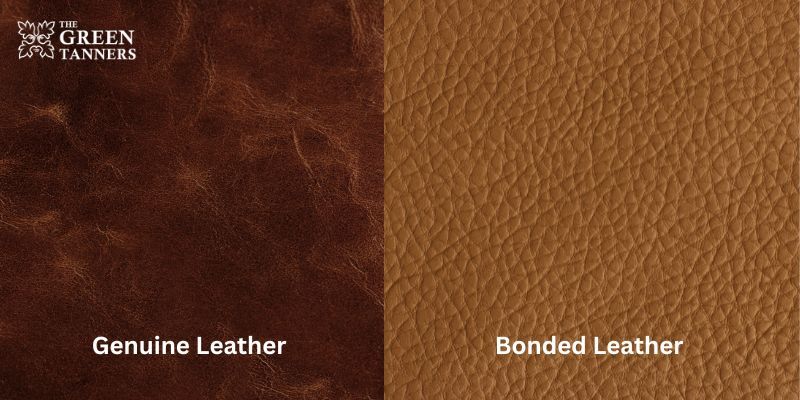What is the difference between Genuine Leather and Bonded Leather?
Posted by The Green Tanners on 11th Feb 2025
What is the Difference Between Bonded Leather vs Genuine Leather?
Think how you would feel about spending your hard-earned money on a chic leather couch, a trendy handbag, or a high-quality office chair only to see it crack, peel, or wear out far more quickly than anticipated. Frustrating, right? The truth is that while they might feel like premium, their quality, durability, and price points differ widely. Some assure exceptional quality at a greater cost, but others offer affordability and little longevity. Thus, how do you know which one is right for you?
This post will explain the major differences between bonded and real leather, their advantages and disadvantages, and which suits you best. Knowing these materials will help you make a wiser choice, whether renovating your furnishings or upgrading your accessories.
What is Genuine Leather?
When searching for leather goods, one often notices the phrase "genuine leather." Though it sounds top-notch, what exactly does it imply? Genuine leather is top-quality leather sourced from cowhide, sheep, or goat skin, giving durability, flexibility, and a timeless appeal.

Composition of Top-Grain Leather
Authentic Leather comes from animal hides such as sheep, goats, or cows. These hides go through a tanning process using chromium salts or vegetable tannins to increase longevity and avoid decomposition. The leather is refined after tanning to give a sleeker finish by removing surface flaws by softly sanding in this stage. It is dyed to match the chosen color, treated with protective coatings for extra strength, and occasionally embossed to provide a unique pattern or texture during finishing. This several-step procedure guarantees that authentic leather appears attractive and retains its durability and life.
Uses of Genuine Leather
Real leather is popular in many fields because of its style and sturdiness. Some of its most usual uses are:
-
Leather Bags & belts: Top brands usually choose top-grain leather to manufacture leather bags and leather belts for their elegant appearance and durability.
-
Bondage products: Genuine leather is preferred for bondage products due to its strength, flexibility, and comfort, ensuring durability and a skin-friendly experience. Unlike bonded leather, it softens over time, resists tearing, and provides a premium sensory feel.
-
Leather Aprons: Many people prefer genuine leather for crafting aprons due to its durability, heat resistance, and premium feel. It's highly demanded by welders, blacksmiths, woodworkers, chefs, and artisans for its rugged protection and long-lasting quality.
-
Leather Shooting and Hunting Accessories: It is ideal for shooting and hunting accessories due to its durability, weather resistance, and classic appeal. It provides a secure grip, long-lasting protection, and a premium feel for gear like rifle cases, shotgun cases, hunting flask cases, and ammo pouches.
-
Leather Jackets and Garments: Mostly, it is used for crafting leather jackets, leather vests and shirts to provide warmth, longevity, and a chic edge.
-
Footwear: From dress shoes to casual boots, real leather provides durability and comfort in footwear.
-
Furniture & Textiles: Used in manufacturing sofas, chairs and car interiors for high-quality sensation and durability.
-
Apparel & Accessories: Belts, watch straps, and gloves made of real leather age well with time.
Pros and Cons of Genuine Leather
The pros and cons of authentic leather are outlined in a table to highlight its productivity.
|
Pros |
Cons |
|
Genuine is particularly long-lasting and robust. |
It is more costly than bonded or fake leather. |
|
Over time, it develops a natural patina and improves its character. |
It needs consistent care to stop drying or splitting. |
|
It is breathable and doesn't create bacteria. |
Prone to water damage if untreated. |
|
Unlike synthetic options, it is resistant to wear and tear. |
What is Bonded Leather?
If you have ever seen an elegant notebook cover or a glossy leather couch at a very low rate, you should know it was made of bonded leather. Bonded leather is a mix of leather scraps and synthetic substances, but it might appear and feel like real leather. Knowing its composition, durability, and manufacturing process will help you make a better choice or see if it meets your needs.

Composition of Bonded Leather
A bonded leather is a synthetic alternative made by combining polyurethane, latex, or other binding materials with shredded leather scraps. Although it includes some genuine leather fibers, they are pulverized and reformed to produce more synthetic than natural material making it cheaper.
Bonded leather is usually embossed with a leather-like texture and coated with synthetic finishes to improve its looks. Therefore, it is quite like genuine leather. It has much lower strength and life than real leather and comprises only a small portion of true leather.
Common Uses of Bonded Leather
Industries frequently use bonded leather to achieve the look of leather at a lower cost. Some common uses are:
-
Furniture: Upholstered bonded leather is common on sofas, reclining chairs, and office chairs.
-
Fashion Accessories: Belts, wallets, and purses made of bonded leather are a cost-effective choice among fashion accessories.
-
Book Covers and Stationery: Notebooks, journals, and Bible covers frequently sport bonded leather for a refined look on book covers and stationery.
-
Car Interiors: Some vehicle manufacturers use bonded leather for seats and interior trims.
Though bonded leather offers a cost-effective solution, its strength and longevity change depending on the quality of the bonding process.
Pros and Cons of Bonded Leather
The advantages and disadvantages of bonded leather, a relatively cheap and flexible material with some limitations in longevity and long-term use, are summarized in this table:
|
Pros |
Cons |
|
It is budget-friendly and less expensive than top-grain leather. |
Not as strong: subject to cracking, chipping, and peeling over time |
|
Options are available for choosing colors, textures, shades and finishes. |
Synthetic coverings make garments less comfortable by limiting breathability. |
|
Sustainable in nature, use recycled leather scraps to reduce waste. |
Unlike real leather, it does not age beautifully or acquire a nicer texture. |
|
A smooth, even appearance for furniture items and decor offers a crisp, finished look. |
Once bonded leather shows signs of wear, it can't be repaired in the same way that natural leather could. |
Bonded vs Genuine Leather: Understanding the Differences
Deciding between bonded and genuine leather depends on your preferences, whether affordability, longevity, or appearance is more essential. Since both substances have different uses, knowing their most appropriate applications will allow you to make a knowledgeable choice.

While at first sight, real leather, and bonded leather can seem similar, a closer examination will show significant distinctions:
1. Material Composition: Real Hide as vs. Leathers scrap
The most notable difference between bonded and genuine leather is their composition.
-
Genuine Leather: Top-grain leather is crafted from the tougher outer skin layers of animal hide. It has top-grain leather, which keeps the natural grain and toughness of the skin, making it an ideal choice.
-
Bonded Leather: A composite material from shredded leather scraps combined with polyurethane, latex, or other synthetic binders. The fragments are coated with a fiber backing to produce a leather-like look. Although it has some actual leather strands, the percentage varies, but in the end, it is more synthetic than organic.
2. Durability: Real Leather Lasts Much Longer
When you are buying leather goods, you should consider their durability.
-
Real Leather: Genuine leather is immensely tough and can last many years with careful maintenance. It resists wear and tear, becoming more beautiful with an unusual patina.
-
Bonded Leather: Much less abrasion since bonded leather is fixed with adhesives rather than a solid hide. It peels, cracks, and flakes over time, particularly in accessories or furniture.
3. Looks and Feels: Natural vs. Even texture
At first look, both types of leather may appear alike, but their texture and appearance sets them apart.
-
Top-Grain Leather: Genuine leather has a rough texture; small flaws and variances make every piece distinctive. Authentic leather becomes softer and acquires a rich look over time, increasing depth and look.
-
Synthetic Leather: Its surface is machine embossed to copy real leather to look even and flawless. It does not have a lot of depth or natural grain, though its texture seems somewhat synthetic. Unlike real leather, it wears out and does not pick up a patina over time.
4. Cost Comparison: Affordability vs. Long-Term Benefit
One thing that usually helps to decide between bonded and real leather is budget.
-
Genuine Leather: Real leather costs more since it is more durable, long-lasting, and of better quality and craftsmanship. Still, it is a long-term investment since it lasts much longer than bonded leather.
-
Bonded Leather: Bonded leather is much less expensive and appeals to frugal consumers. Still, it deteriorates more quickly.
5. Keeping and Care: Simple to Advanced Cleaners
Maintenance needs vary between these two types of material, and good upkeep might lengthen the life of any leather product.
-
Genuine leather: Regular conditioning is needed to maintain it soft, hydrated, and crack-free. To avoid harm, keep it out of direct sunlight and contact with too much humidity.
-
Synthetic Leather: Since it has a synthetic coating, bonded leather is easier to clean and more resistant to stains and spills. Once it starts peeling, there is no way to fix it.
Factors to Consider When Buying Leather Products
Consider the below before buying.
-
Budget: Are you seeking a low-cost option or willing to spend on long-term quality?
-
Durability: Should the item be used occasionally, or will it encounter wear and tear daily?
-
Aesthetic Appeal: Would you rather have a uniform, polished look or a natural leather appearance that ages nicely?
-
Maintenance: Are you comfortable conditioning your leather items regularly, or do you want something low maintenance?
Final Thoughts: Which One Would You Select?
The best leather choice depends on what you need. Genuine leather comes on top if you seek long-term value, authenticity, and durability. It ages wonderfully, lasts many years, and gives a sumptuous, rich feel. Conversely, bonded leather could be better if affordability is your top priority.
If you want products that last longer and age well, real leather is a wiser purchase for everyday basics such as bags, coats, and furniture. But if you seek budget-priced temporary furnishings or decorative items, bonded leather could be a good option. Bonded leather is a good option if you only need the product for short-term use. Certainly, genuine leather is the obvious choice if you want a long-term investment.
Ultimately, knowing these variances enables you to buy more consciously. Whether you choose genuine or bonded leather, be sure it fits your budget and expectations.











